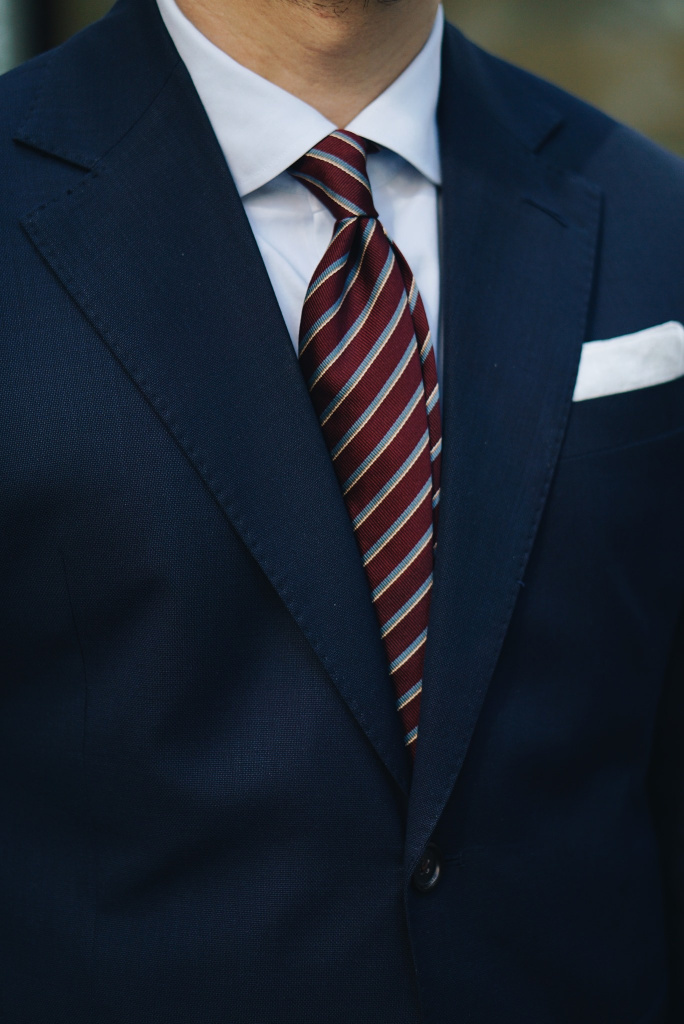Throughout most of the nineteenth century, all gentleman underclothing was made of linen. The word “linen” became a generic term for a man‘s underwear. The dress shirt functioned exactly like the modern T-shirt by keeping sweat away from the outer garments while protecting the body from the coarse outerwear materials. However, propriety demanded that only its collar and cuff be visible, hence the term “showing linen” meant that white linen at the neck and hand was a sign of gentility. As recently as the late 1940s, it was as shocking for a man to expose his dress shirt in polite society as it would have been for a woman to walk into a restaurant wearing nothing over her brassiere.
The modern dress shirt’s shape developed during Victorian times as men donned tight waistcoats, forerunners of the modern vest, thus rendering the full-cut shirt obsolete. Once the current dress shirt’s body shape was established, the collar became its most distinguishing and fashion-sensitive feature. In 1820, a housewife in Troy, New York, changed the face of men‘s fashion. Hanna Montague was the wife of a fastidious blacksmith who insisted on a clean shirt every evening to attend his civic engagements. Vexed by the daily drudgery of laundering, she liberated both the shirt and herself by cutting off the collars, binding the edges and neckbands, and attaching strings to hold them in place.
At first, Mr. Montague was disturbed by his detachable collar, but the idea caught on among his friends, and soon Troy housewives were snipping away. The owner of a general store recognized the commercial possibilities of this simpler shirt and started manufacturing some in his backroom. Almost overnight, Troy abounded with shops clamoring to turn out the detachable collar. In Fact, American shirt-making giants such as Cluett Peabody and Phillips Van Heusen first began as separate-collar manufacturers in the Troy area. Separate collars rose to the pinnacle of fashion in the years preceding the First World War, when the commercial artist J. C. Leyendecker created the male equivalent of the Famous Gibson girl, the legendary Arrow Collar Man.
As sportswear came into being during the second half of the nineteenth century, so did the separate double, or turned-down, collar. However. war forever changed its destiny. With five million men serving their country in government-issue soft attach-collar shirts, the war dealt a blow to the separate stiff collar from which it never recovered. By the 1920s, Critics lamented that the United States was alone in its espousal of the collar attached shirt for town wear. By the early 1930s, soft double collars were accompanying the new dinner jacket, a development that sparked considerable debate. Advocates of the stiff collar regarded it as the keystone of classical male elegance, the last bastion against slovenliness.
A youthful Anthony Eden dons a dress shirt with a stiff attached straight, point collar. Notice how tightly knotted and therefore, small, the knot had to be to fit into its starched environs. The knot’s positioning up. into. and directly out from under the stiff collar’s inverted “V” point became the criteria of smartness For the emerging soft collar fashions. Just as the tailcoat mentored the dinner jacket’s evolution, the older stiff collar design abetted that of the newer soft attached collar design abetted that of the new soft attached-collar decorum. Even today, a dress shirt appointed with a purposely tied necktie affecting a crisp knot sitting high in its collar is still an expression of an authoritative and polished practitioner.

This story was sharing about the history of the mordern collar, cuffs which are most important for the shirt. We will continue with this guide and show you how to dress them are better for everyone.
Source: Dressing the Man Mastering the Art of Permanent Fashion by Alan Flusser

